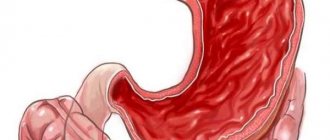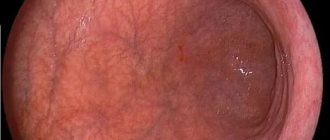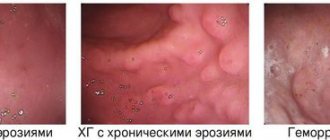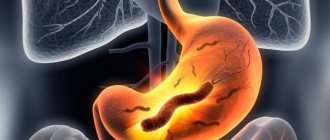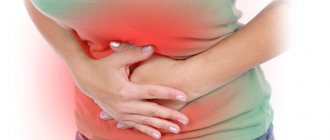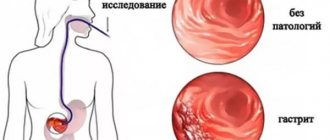Degrees of gastritis: 1, 2 and 3, treatment at each stage
Currently, many people suffer from some kind of digestive disease. One of them is gastritis. This is an inflammation of the stomach lining. Doctors distinguish two forms of this disease: acute and chronic.
- Acute form. Most often it occurs, for example, due to poisoning of the body, alcohol consumption, overdose of medications or excessive consumption of spicy foods. That is, the occurrence of this form is influenced by everything that negatively affects the body.
- Chronic stage. Development occurs slowly; in the first stages, a person does not even notice pronounced symptoms. Inflammation occurs in the gastric mucosa. As a result, the functioning of the stomach is disrupted, acid is released, and so on.
Morphological changes in gastritis
The morphological classification of gastritis is widely used in practice, since it is the histological characteristics of the process that help determine the prognosis and treatment tactics for the patient. For this purpose, a visual analogue scale is used.
It allows you to evaluate the morphological picture of the gastric mucosa according to the degree of H. pylori contamination (absent, weak, medium, strong); according to the severity of the inflammatory process and the activity of gastritis - leukocyte infiltration. The degree of gastric atrophy during gastritis is also assessed using a visual analogue scale.
Morphological classification of gastritis is widely used in practice
According to the severity of atrophy and its type, three categories of changes in the gastric mucosa are distinguished:
- absence of atrophy: the typical cellular structure of the mucosa is preserved, the main glands with a sufficient number of parietal and main cells are visible in the preparation;
- unconfirmed atrophy : inflammatory infiltration is pronounced, the main glands are relatively reduced, there is no proliferation of connective tissue;
- metaplastic atrophy: - glands of the mucous membrane are replaced by pyloric or intestinal glands;
- non-metaplastic :—the glands characteristic of the stomach are preserved, but their number is significantly reduced.
This takes into account the localization and severity of atrophic changes (weak, medium, strong), as well as the presence and area of foci of intestinal metaplasia.
Onset of the disease: gastritis degree 1
Doctors distinguish three degrees of stomach disease: 1, 2 and 3. Stage 1 gastritis is called superficial. Its main symptoms:
- appetite decreases, general weakness, fatigue, and sometimes dizziness appear;
- nausea, diarrhea;
- cramping pain in the abdominal cavity;
- The blood pressure drops and the pulse quickens.
Despite this, this degree of gastritis is the most harmless, since there are no focal lesions, the gastric mucosa has superficial inflammation and the internal tissues of the duodenum and stomach still remain intact.
Many patients often come to the clinic with stage 1 gastritis, but the disease at this stage is not dangerous. Despite this, the disease should be treated immediately, as it can progress to the next stage, called chronic. In the recent past, superficial gastritis was not positioned as an independent disease. Stage 1 was monitored and observed by doctors, but no special treatment measures were taken. Over time, practice has confirmed that stage 1 gastritis should never be ignored, since due to lost time there is a rapid transition from superficial inflammation to the chronic stage of the disease.
How to treat grade 2 and 3 gastritis?
First you need to get rid of all bad habits. It is also necessary to monitor your diet: include only healthy foods in your diet, give up fast food, and do not overeat. The doctor must prescribe you antibiotics to effectively treat the disease.
Gastritis of the 2nd degree is called erosive. At this stage, the gastric mucosa begins to break down. Main symptoms:
- vomiting appears with blood;
- constant heartburn;
- acute pain in the stomach, especially after eating;
- diarrhea mixed with blood.
It should be noted that all these symptoms begin to appear sharply, the person’s condition worsens significantly, and the disease begins to progress.
Gastritis stage 2 - treatment must be carried out immediately. This process is called endoscopy: an endoscope (a special tube equipped with a camera) is inserted into the patient’s stomach. The doctor identifies erosive ulcers on the walls of the stomach. In addition to this procedure, it is necessary to take a blood test, stool test, and sometimes an x-ray is prescribed.
Gastritis grade 3 - atrophic. How does it manifest itself?
- Heartburn and belching are becoming more frequent.
- The intestines begin to malfunction: loose stools appear, rumbling in the stomach.
- The person feels weak, suffers from dizziness, loses appetite and loses weight over time.
- Constant heaviness in the stomach.
This disease at any stage should be treated immediately. How? First, give up bad habits and stick to a healthy diet. Secondly, follow all the doctor’s recommendations and take the antibiotics he prescribed.
Diet
If the disease has worsened, then the food should be as healthy as possible: warm, with no seasonings. You need to eat often, but in small portions. Milk or other dairy products should also be present in the diet. Watch your health, as all stages of this disease are dangerous in their own way.
Causes of inflammation
Superficial gastritis develops when the diet is disrupted. Bad habits and non-compliance with the regime can also affect its formation. There is an opinion that gastritis 1 tbsp. Act. has a hereditary factor. Thus, the main causes of inflammation are identified:
- smoking;
- alcohol consumption;
- addiction to spicy foods;
- irritation from hot and cold foods;
- long breaks between meals;
- heart pathologies;
- diseases of the digestive system.
Superficial gastritis is formed when eating spicy foods
In addition to the above, importance is also paid to the condition of the oral cavity. While chewing food, bacteria located on the surface of the teeth and in carious cavities enter the stomach cavity with the food bolus. If the protective properties are impaired due to poor blood circulation or endocrine changes, the pathogen attaches to the mucous membrane and begins to multiply, causing inflammation or gastritis stage 1. Act.
In order to cure superficial gastritis, it is important to examine the patient and determine the source of infection, as well as the pathologies contributing to the development of the disease. But still, as studies have shown, the main cause of inflammation is Helicobacter. Infection can occur through the use of shared utensils and even during contact. The pathogen stays in the body for a long time without causing any abnormalities.
Only under favorable conditions does the bacterium become fixed on the mucous membrane, causing irritation. This leads to disruption of secretory function, which, if left untreated, can cause ulceration. Thus, erosive gastritis and ulcers are formed.
The main cause of gastritis is Helicobacter
Superficial gastritis
Gastritis of the 1st degree is a superficial or catarrhal type of disease, characterized by dysfunction of the stomach, while there is a slight thickening of the mucous membrane of the organ without violating its integrity. The initial stage of gastritis provokes an asymptomatic course of the disease, or from time to time the following may occur:
- nausea;
- weakness accompanied by low blood pressure;
- minor pain in the abdomen, especially in the upper part;
- lack of appetite;
- white coating on the tongue;
- belching.
If these symptoms occur, you should immediately contact a gastroenterologist to receive timely and high-quality treatment.
The first symptoms of gastritis in the initial stage
Gastritis is an inflammation of the gastric mucosa, but this medical term covers not one, but a group of gastroenterological diseases accompanied by a variety of disorders.
The most common cause of gastritis is an infection, the same one that provokes the development of stomach ulcers, but we must not forget about other causes: poor diet, injuries, taking medications. In the most advanced cases, gastritis can develop into a stomach ulcer or increase a person's chances of getting cancer.
There are acute and chronic gastritis. The differences in symptoms are clear even from the name. Acute gastritis occurs quickly, proceeds violently, the symptoms are pronounced and painful. A chronic patient may not notice his illness; he will only notice periodic aching pain and a feeling of fullness in the stomach. Many people with chronic gastritis live for a long time without giving it any importance. A rare but common and dangerous symptom is gastric bleeding. In this case, seeking medical help is mandatory.
Despite a lot of unpleasant sensations, gastritis, if diagnosed in time, can be easily treated at an early stage. Needless to say, curing acute gastritis is much easier and faster than chronic gastritis. In such cases, doctors say that a person will get rid of the disease as long as it took him to earn it.
The first symptoms of gastritis appear in the initial stage and in a mild form:
- indigestion accompanied by acute pain;
- belching; vomit;
- nausea; lack of appetite.
The first symptoms of gastritis in children at the initial stage of the disease
Gastritis in children occurs at the age of 3-6 years, when the child is often susceptible to infections and viral diseases, and at the age of 10-13 years, when the body enters a state of puberty and is often exposed to stress and emotional experiences.
Primary gastritis in children occurs from improper food bacteria parasites fungi excess food food allergies
Depending on the causes of gastritis, acute primary and secondary gastritis in children are distinguished. Primary gastritis occurs from the wrong foods, bacteria, parasites, fungi, excess food, food allergies. The secondary form can be caused by infectious diseases: rubella, measles, influenza, diphtheria, septic inflammation. The infection that caused the disease may end up in the gastric mucosa.
Signs of gastritis in children at the initial stage appear clearly and are easy to notice:
- fever and increased temperature;
- nervous condition, insomnia, crying for no reason;
- pale skin, blue circles under the eyes;
- loss of appetite, abdominal pain;
- the formation of plaque on the tongue of different colors;
- dry mouth or increased salivation;
- belching;
- nausea, vomiting, diarrhea.
With chronic gastritis, the child develops general weakness, apathy, loss of appetite, intestinal upset, belching after eating, and severe weight loss.
Chronic gastritis
The chronic form is grade 2 gastritis, which occurs when the superficial stage of the disease is untimely or improperly treated and is accompanied by a change in the secretory function of the stomach (food cannot be properly processed) and a significant increase in the content of leukocytes in the blood.
Symptoms of this stage of the disease are:
- pain on an empty stomach or after eating;
- vomiting (sometimes with blood);
- heartburn;
- heaviness in the stomach, sometimes with blood;
- loose stools with bloody discharge.
The second degree of gastritis has the following types:
- erosive (the mucous membrane is covered with erosion, which can bleed);
- diffuse (damage to the glands, in which their production of enzymes becomes difficult).
At this stage, the patient may be hospitalized, since the disease may become progressive. Treatment consists of taking medications and strictly following a diet similar to that prescribed for superficial gastritis.
The first stage of gastritis: symptoms and nutrition at an early stage
As is known. It is easier to prevent any disease than to treat it. The first stage of gastritis is when everything is just beginning and it is still possible to restore the health of your stomach. Of course, the symptoms of the first stage of gastritis remind a person that it is time to take action, change his diet or start taking medications. Superficial gastritis precedes the development of the disease; by recognizing the symptoms of gastritis at an early stage, you can avoid exacerbation of the disease. Nutrition at stage 1 of gastritis also has its own characteristics, read about this on the website gastritinform.ru
Atrophic gastritis
This stage is considered an advanced form of gastritis, characterized by deep damage to the gastric mucosa down to the muscles, a gradual increase in the number of dead cells being replaced by the thick intestinal layer. The stomach ceases to perform digestive function. Food stagnates, the acidity of the stomach is disrupted, this leads to an increase in the number of bacteria and the release of toxins, which can trigger the formation of cancer cells.
This form of the disease is accompanied by constant pain in the gastrointestinal tract, sudden weight loss, bitterness in the mouth, heartburn and belching, diarrhea, and vomiting.
In addition to diet, urgent antibacterial and absorbable therapy, drug treatment aimed at restoring the functioning of the stomach are necessary, in some cases immediate surgical intervention is required.
Most experts distinguish 3 degrees of gastritis, but some also note a hypertrophic stage (Menetrier's disease), but it is rare and therefore has not yet been properly studied. This stage is manifested by severe deformation of the gastric mucosa and its serious thickening. The disease is accompanied by a severe form of anemia.
Diet features
It is important to emphasize that there is no point in treating stomach inflammation with the most effective drugs if the provoking factor is not eliminated. In this regard, patients with this disease should avoid bad habits and plan a regimen. Particular attention should be paid to the issue of preparing a diet.
Superficial gastritis requires adherence to a diet even without an exacerbation. In this case, you need to eat food 5-6 times a day. Portions should be small. It is especially important not to overload your stomach before bed. All food should be warm, after heat treatment, and in the acute period, crushed.
Food consumed for superficial gastritis should be warm and crushed
When choosing foods, preference should be given to protein foods, which have a positive effect on regeneration processes.
Meat, fish, and cereals of all kinds are required. To increase overall immunity, it is important to eat vegetables and fruits, but only after heat treatment. Dishes need to be boiled, baked and steamed. It is strictly forbidden to consume fried foods, fatty, hot spices, alcohol, pickles, marinades, and so on.
If you start treating inflammation in time, you can not only eliminate complications such as peptic ulcers, erosive gastritis, duodenitis, but also completely get rid of the disease, restoring the function of the organ. At the same time, attention should be paid to all factors: follow a diet, normalize your regimen, avoid stress and be sure to take prescribed medications.
The video will talk about gastritis:
Types of gastritis
In accordance with the etiology, according to one of the first systematizations of chronic gastritis in 1973, the following types of gastritis are distinguished:
- type A (autoimmune);
- type B (bacterial, about 90% of all patients with chronic gastritis), occurs when the bacteria Helicobacter pylori penetrates;
- type C (reflux gastritis) - damage to the stomach with the formation of erosions that can degenerate into a stomach ulcer.
Type A gastritis occurs when there is a conflict between immune cells and the gastric mucosa, i.e. the body produces antibodies that contribute to intoxication of the entire human body, which, in turn, leads to the death of cells in the gastric mucosa, the excessive formation of which triggers the development of cancer. The main reason for the manifestation of this type of disease is considered to be a genetic predisposition in combination with a weak immune system.
Factors contributing to the manifestation of type A disease are bad habits, poor nutrition using various diets, fasting and even overeating; excessive consumption of cold, hot, fatty, spicy foods.
Signs of autoimmune gastritis:
- heaviness in the stomach;
- bloating, rumbling, pain in the stomach;
- nausea;
- heartburn;
- unpleasant taste and odor from the mouth;
- significant weight loss;
- constipation, diarrhea;
- white coating on the tongue;
- brittle nails and hair;
- sleep disturbance;
- increased blood pressure.
Type B gastritis is caused by Helicobacter pylori bacteria (about 99%) and other viruses that enter the human body. These microorganisms penetrate the gastric mucosa, causing inflammation, and in some cases, necrosis of some of its cells, causing a significant increase in acidity.
The symptoms of the disease are similar to those of the autoimmune type of pathology, however, a number of distinctive signs arise:
- cramping pain in the stomach;
- nausea often provokes vomiting;
- possible bleeding in the stomach;
- sour belching;
- burning in the digestive tract.
Type C gastritis is also called chemical gastritis.
It causes reflux of intestinal contents, including bile acids, into the stomach, which causes injury to the mucous membrane and leads to cell degeneration.
This type of gastritis is characterized by pain and heaviness in the stomach, nausea, vomiting, and heartburn.
Gastritis of the stomach at the initial stage of the disease
Do not underestimate gastritis, as it affects the general condition of the body. Gastritis can manifest itself with various symptoms depending on the form and degree of the disease and can proceed unnoticed.
The main symptom of gastritis at the initial stage is sharp pain in the solar plexus, which manifests itself more acutely when consuming certain types of foods, drinks, drugs, especially foods with increased irritability to the gastric mucosa. Pain may occur between meals. There is constant or periodic pain in the solar plexus area immediately after eating or during fasting.
Symptoms of gastritis at the initial stage also include heartburn, vomiting, and belching. Morning sickness, vomiting with bile, sometimes with bloody discharge may occur. There is bloating, frequent release of gases, and a taste of bile and metal. Painful sensations may be accompanied by headache, dizziness, and rapid heartbeat. The color of stool changes, the skin and mucous membranes of the eyes turn pale. Sometimes you may experience intense thirst and increased salivation.
The symptoms of chronic gastritis are more difficult to determine. For a long time, a person may not notice any special signs. You may experience irregular bowel movements, a coating on the tongue, fatigue, rumbling and noise in the stomach between meals, bloating, and occasional diarrhea or constipation.
Chronic gastritis affects the quality of life, but does not greatly affect the patient’s health. At the initial stage, chronic gastritis can manifest itself as a disorder of the digestive system. In a more advanced stage, chronic gastritis causes constant gas production, anemia, drowsiness, temperature changes and increased sweating, increased rumbling in the stomach, bad breath, heaviness after eating.
Superficial gastritis initial stage of the disease causes symptoms
Superficial gastritis is one of the types of gastritis, which is characterized by inflammation of the mucous membrane and damage to the inner lining of the stomach. It is the safest form of gastritis. The inflammatory process can affect the area at the exit from the stomach into the duodenum, then antral gastritis occurs.
Superficial gastritis is the safest form of gastritis
The development of superficial gastritis can be caused by the consumption of irregular and unhealthy food, hot and cold dishes, seasonings and spices, passion for alcoholic beverages, sweets, and smoking. Negative factors also include regular use of acid-based medications, chemical poisoning, and the presence of the Helicobacter pylori bacterium in the stomach.
Among the main symptoms of superficial gastritis is pain that occurs in the solar plexus. It manifests itself more acutely when consuming spicy and heavy foods, carbonated and alcoholic drinks, as irritation of the gastric mucosa occurs. After eating, the feeling of discomfort in the stomach increases. The pain may be point-like, which means that the patient has a focal form of superficial gastritis.
Features of the occurrence and course of the disease
Gastritis is an inflammation of the mucous walls of the stomach. One of the causes of inflammation is the entry of Helicobacter pylori bacteria into the stomach. The reproduction rate of bacteria is very low, so they gradually spread over the entire surface of the gastric mucosa, and the patient practically does not feel any changes in the body. Symptoms in the early stages of gastritis are very mild.
Helicobacter pylor bacterium under a microscope
Gastritis can be either acute or chronic. An acute attack of the disease occurs due to poisoning or a sharp change in the amount of gastric juice in the body. For example, after eating food that is too spicy and unusual for the stomach. The disease is expressed by acute abdominal pain and a severe deterioration in the general condition of the patient.
Sometimes the disease begins with a slight irritation of the stomach, which may be asymptomatic. If gastritis develops gradually, the disease smoothly passes through all three stages.
First stage of gastritis
Stage 1 gastritis is called superficial or catarrhal. At this stage of the disease, irritation of the epithelial cells of the stomach occurs. The disease does not affect functional tissues, thus at this phase the degree of damage to gastritis of the stomach is minimal and can be easily treated.
Symptoms of the first stage:
- mild pain in the upper abdomen;
- pain under the ribs on the right;
- nausea and vomiting;
- loss of appetite;
- low pressure;
- general weakness;
- dizziness;
- white coating on the tongue;
- flatulence.
Nausea is one of the symptoms of the first stage of gastritis
The first stage of gastritis can be completely asymptomatic. If you have any doubts that you may have gastritis, consult your doctor. A gastroenterologist deals with stomach problems. He will prescribe all the necessary procedures, such as a probe, tests, and, if necessary, x-rays. Often with this disease, a blood test shows neutrophilic leukocytosis.
In addition to the prescribed treatment, if the disease is detected, temporarily limit your diet. Reduce your consumption of salt and spices, cook only in the oven or steam. Try to eat a lot of soups. Both vegetable soups and chicken broths are suitable. It is also worth eating buckwheat, rice or semolina porridge.
Second stage of gastritis
Stage 2 gastritis is erosive. During this period, the disease begins to take on a chronic form. Inflammation spreads to several areas of the gastric mucosa. The surface layer of the organ is destroyed due to erosion. As a result, the stomach is covered with small open wounds.
Diffuse chronic gastritis also occurs. It affects the endocrine glands, thereby preventing cells from producing the necessary enzymes. Both erosive and diffuse gastritis disrupt the functioning of the stomach, causing serious digestive problems.
The main symptoms of the second stage of gastritis:
- severe aching pain after eating;
- regular heartburn;
- constant feeling of heaviness in the stomach and oversaturation;
- loose stools (possible blood);
- vomiting (may be with blood);
- severe lethargy.
Severe aching pain after eating is the main symptom of the second stage of the disease.
If you have any of the symptoms, be sure to consult a doctor. In the chronic stage of the disease, immediate hospitalization may be required. The gastroenterologist will conduct an examination using a probe. Additional tests may also be needed, such as blood and stool samples, x-rays, and biopsies. If gastritis is detected, you will need to take a test for the presence of Helicobacter pylori bacteria. This is a causative agent of the disease that can be effectively treated with medications.
The diet at the second stage must be strict
The diet at stage 2 should be much stricter than at stage 1. It is forbidden to consume spices and salty foods. Under no circumstances should you eat smoked or pickled foods; you should avoid eating baked goods and sweets. Vegetables and fruits cannot be eaten fresh. You can either stew vegetables or steam them. Fruits can be eaten in the form of fruit purees.
Symptoms
As a rule, the initial stages of cancer development often occur without the manifestation of a characteristic clinical picture. The first signs appear at a later stage. This is considered dangerous for the body, since malignancy of the ulcer or atrophy of the organ mucosa cannot be detected in a timely manner.
For this reason, if a person has stomach diseases, he needs to be regularly examined by a gastroenterologist.
Among the main signs of the development of infiltrative cancer are:
- low level of acidity, which manifests itself in disorders of the functioning of the digestive glands;
- attacks of nausea and vomiting;
- epigastric pain that has nothing to do with eating;
- internal bleeding;
- lack of appetite;
- increased fatigue;
- general weakness.
To eliminate the above symptoms, it is necessary to adjust your diet. However, it must be remembered that such a measure does not help cure the patient.
Features of gastritis - stages, causes and prevention
Gastritis is inflammation of the stomach. The disease is quite serious and can cause complications.
gastritis
Stages of gastritis
Gastritis can occur in a mild form, but then it can provoke erosion, cause ulcers and even stomach cancer. A mild form of the disease, without erosion, occurs in every third person.
Gastritis, which has passed into the stage of erosion, occurs in 10% of people. Doctors see quite a lot of patients diagnosed with gastritis. The reason is that doctors cannot completely cure the disease. By the age of forty, half of people suffer from gastritis. This is very sad.
Types of gastritis
Ordinary people not familiar with medicine know that gastritis can be acute and chronic. They also know that gastritis occurs with high and low acidity. But doctors divide the disease into many types - catarrhal, necrotic, fibrinous, autoimmune and others. Often doctors, and even more so their patients, are confused in all these terms. Let's look at the main forms of gastritis.
1. The acute form of the disease can occur without pain. Acute gastritis is caused by an infection and is treated in an infectious diseases hospital. If gastritis appears no earlier than three months, the patient is also sent for treatment to the infectious diseases department. In other cases, a chronic form of gastritis is diagnosed.
2. Increased or decreased acidity. Today the definition is very vague. But doctors, explaining to their patients the cause of their illness, resort to such terms. By hyperacidity they mean reflux disease. By low acidity they define atrophic gastritis.
3. A total of 20 types of gastritis have been identified. It depends on the location and intensity of the inflammation, the causes of the disease. In real life, there are 5 types of gastritis. These are Helicobacter, acute, atrophic, medicinal and reactive.
stomach ulcer, gastritis
Diagnosis of gastritis
Unfortunately, to identify the exact type of gastritis, signs alone are not enough. Treatment depends entirely on the type of disease. An incorrect diagnosis can lead to incorrect treatment, which can even worsen the patient's condition. Therefore, it is necessary to identify the type of gastritis before starting its treatment. It must be admitted that only one out of three patients has gastritis with symptoms. Other patients do not have this symptom, but gastritis immediately develops into an ulcer, erosion, and can even provoke stomach cancer.
1. To establish a diagnosis, the doctor first examines the patient’s abdomen. However, abdominal pain may appear if the intestines, pancreas, or bladder are diseased. Such diseases need to be treated differently.
2. A gastroenterologist prescribes a gastroscopy for a patient and takes the patient’s stool and blood for analysis. These examinations are enough for an experienced doctor to determine the type of gastritis.
Other connections and other types of non-erosive gastritis
Pernicytic anemia.
Pernicytosis anemia occurs as a result of severe atrophic gastritis of the acid-producing mucosa with achlorhydria, which impairs the secretion of intrinsic factor, and subsequent malabsorption of vitamin B12.
Most patients have minimal or no associated antral gastritis and therefore have high plasma gastrin levels because gastrin is secreted in response to achlorhydria. In fact, when gastroscopy is performed for unexplained hypergastrinemia, severe atrophic gastritis is the main finding. Many patients with severe atrophic gastritis and achlorhydria still have normal or near-normal levels of vitamin B12 absorption. They are likely to develop vitamin B12 malabsorption over time. An endoscopic biopsy is performed when a diagnosis of severe atrophic gastritis is suspected. If the Schilling
is used to make the diagnosis of pernicytous anemia, endoscopic examination should still be performed to identify the presence of any polypoid lesions, which sometimes occur in severe atrophic gastritis (gastric carcinoid and, less commonly, gastric adenomas or adenocarcinoma).
Reactive gastropathy. The definition of reactive gastropathy was given above. In addition to the fact that reactive gastropathy is a common finding in areas adjacent to the edges of ulcers and erosions, it is also found around anastomoses (stomies) after gastrectomy. With stomal reactive gastropathy, vascular congestion is also usually present.
Lymphocytic gastritis.
Lymphocytic gastritis is a recently recognized histological type characterized by massive lymphocytic infiltration of epithelial cells that is not necessarily present in the lamina propria below the epithelium. Lymphocytic gastritis is not a variant of HP gastritis. Currently, it is of interest because... it is a “new” pathway of injury and also due to associated conditions. Associated conditions include virtually all cases of diffuse pox-like gastritis (rare in North America), some cases of celiac disease, and some cases of Ménétrier's disease. Lymphocytic gastritis can also be found on biopsy in patients without visible pathology.
Specific types of gastritis.
Specific gastritis is associated with more specific histological (and sometimes obvious endoscopic) features that can provide a basis for diagnosis (eg, cytomegalovirus) or, if not, can significantly narrow the differential diagnosis, which is of great therapeutic or prognostic value. Specific types of gastritis are rare. Infectious types are most important, especially in immunocompromised patients in whom cytomegalovirus infection is common. In addition to infectious gastritis, other specific gastritis include lesions limited to the stomach, such as Menetrie
,
gastrointestinal disorders that also involve other parts of the intestine, such as Crohn's disease, and finally, systemic diseases, such as sarcoidosis.
Third degree gastritis
Atrophic gastritis – the most severe stage 3. Deep damage occurs to the superficial tissues down to the muscle plate layer. As you know, muscles contain blood vessels, veins, and nerve endings. This stage, which is extremely painful for the patient, is dangerous because as a result, the atrophied cells of the mucosal surface begin to be replaced by the thick intestinal layer. Many ulcers, cysts, and adenomas form, taking a malignant form. The stomach ceases to fulfill its main purpose - digesting food.
- constant pain;
- food obstruction;
- sudden loss of body weight;
- chronic heartburn and belching;
- weakness to the point of dizziness;
- diarrhea and vomiting.
Due to disruption of the digestion process of stage 3, food stagnates. The bacteria Helicobacter pylori in disturbed acidity begin to develop actively, producing alkali and toxins that can disable the body.
Urgent measures are required: antibacterial therapy, a strict diet, medications that help restore the functioning of organs and maintain the health of other body systems, resorption therapy. Urgent surgery is possible.
Treatment of gastritis
If you enter “ gastritis symptoms and treatment” , it will give advice that is designed for the “average patient.” And as we already understood, this disease has different causes and forms of progression, so gastritis must be treated individually, eliminating the root cause, and only with the participation of a doctor. However, there are also universal recommendations, without which there will be no success in treatment.
For all types of gastritis, the mandatory rule is diet, giving up bad habits and reducing stress factors.
What can you eat if you have gastritis?
In case of acute gastritis or severe exacerbation of chronic gastritis, diet 1A is recommended for the first 2 weeks, when all dishes are served pureed and mushy. All vegetables and fruits in any form, as well as bread, are prohibited.
After the acute condition is relieved, you can switch to diet 1. All dishes should be consumed only boiled, steamed or baked (without crust!).
Allowed cereals are semolina, buckwheat, rice, oatmeal. Prohibited: pearl barley, millet, barley. Bread can only be made from fine flour, yesterday's bread or slightly dried. Both hot and cold foods are excluded.
All spicy, sour, smoked, canned foods, strong broths, seasonings, ketchups, pickles, mushrooms, onions, garlic, white cabbage, tomatoes, coffee, chocolate, strong tea, sharp and salty cheeses, fatty meats, baked goods and puff pastry are prohibited. . If you have gastritis, you should consume less salt, as it irritates the walls of the stomach.
Second degree gastritis
Erosive gastritis is the 2nd stage of gastritis development. The name refers to the destruction of the surface layer of the epithelium through the formation of erosion. One layer becomes covered with wounds, causing bloody discharge. A stage 2 manifestation occurs, called diffuse. The diffuse form affects glands that are no longer able to perform the basic functions of producing enzymes. Both types of second degree are chronic and severe. Affect the functioning of the gastrointestinal tract system.
Symptoms of stage 2 gastritis:
- severe pain, aggravated after eating;
- heartburn;
- vomiting, sometimes with blood;
- loose stools with bloody discharge;
- severe weakness.
It is necessary to take immediate measures, including hospitalization. Get tested for blood content in stool and urine. Carry out hardware diagnostic procedures. A strict diet and medications are recommended to improve the condition. Unfortunately, at this stage the disease is already chronic, capable of taking a regressive and progressive turn, and is treated under strict medical supervision.

